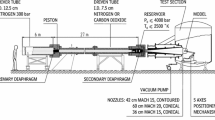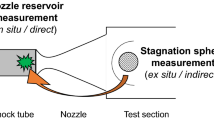Abstract
The active cooling of aerospace structures can be performed by the use of porous materials. It requires characterizing its permeability to predict the cooling efficiency by means of Computational Fluid Dynamics codes. The Darcian term is generally deduced experimentally from a relationship between the mass flow rate and the pressure drop through the porous media. Due to thermo-chemical process involved in the cooling, the permeability can change. It is currently not possible with common techniques to determine these variations during the flight. This paper presents a novel approach taking advantage of well known flow behaviour in chemical reactor engineering in order to propose a real-time in situ quantification of the Darcian permeability. The residence time distribution is analyzed thanks to tracer injection and to associated experimental measures of Infra-Red signals. The IR peak characteristics (height, width, surface, rising and falling gradients) and time delays are analyzed and correlated to physical parameters (mass flow rate, injected mass of tracer, properties of fluids). The peak height and surface and the rising gradient vary linearly in the same sense as the injected tracer mass while the falling gradient varies in the opposite sense. Both gradients decrease with a mass flow rate increase. The time delay between injection and detection of the tracer is quite constant except when changing the fluid nature. A design of experiments allowed estimating quantitatively the influence of each physical parameter on the optical one of the IR signal. Thanks to this first understanding, the Darcian permeability is linked to the observed IR signal. A linear regression is proposed with the peak width which is judged to be the most relevant parameter. Finally, an analytical approach is developed to fit ordinary differential equations to IR peak measures and to correlate the parameters of the law to the Darcian permeability. Several laws (linear, logarithmic and power) are proposed depending on the parameter but the linear regression involving the coefficient noted β 1 is the most promising. One of the advantages of this method is to be able measuring the permeability during the flight and not only on-ground with specific test facility.














Similar content being viewed by others
Abbreviations
- K D :
-
Darcian permeability (m²)
- K F :
-
Forchheimer permeability (m)
- L :
-
Porous media thickness (m)
- P :
-
Pressure (Pa)
- Q :
-
Flow rate (m3 s−1)
- T :
-
Time (s)
- ν :
-
Fluid velocity (m s−1)
- V :
-
Volume (m3)
- X :
-
Mole fraction ()
- α :
-
Adjustment coefficient
- β :
-
Adjustment coefficient
- Μ :
-
Dynamic viscosity (Pa.s)
- ΔP :
-
Pressure drop through the porous material (Inlet Pressure minus outlet one, in Pa)
- μ :
-
Density (kg m−3)
- 0 :
-
Subscript for initial conditions (time t=0)
- Bench :
-
Subscript for the bench outlet
- Cell :
-
Subscript for FTIR (Fourier Transform Infra Red spectrometer) optical cell
- Inlet :
-
Subscript referring to inlet conditions of the cell or of the bench
References
M. Bouchez et al. Material-aero-thermal interaction computations in the ATLLAS European programme, AIAA-2008-4670 (2008)
M. Bouchez et al. Multi-level coupled simulations of cooled structures in the ATLLAS European programme, AIAA 2009-7355 (2009)
N. Gascoin et al. Permeation of inert and supercritical reactive fluids through metallic and composite media, AIAA-2010-6551 (2010)
T. Langener, J. von Wolfersdorf, T. Laux, J. Steelant, Experimental investigation of transpiration cooling with subsonic and supersonic flows at moderate temperature levels, AIAA 2008-5174 (2008)
J. Steelant, Achievements obtained on aero-thermal loaded materials for high-speed atmospheric vehicles within ATLLAS, AIAA-2009-7225 (2009)
G. Fau, N. Gascoin, P. Gillard, M. Bouchez, J. Steelant, Fuel pyrolysis through porous media: coke formation and coupled effect on permeability, 17th hypersonic. AIAA, San Francisco, 11–14th April (2011)
N. Gascoin, P. Gillard, M. Bouchez, Chemical composition and mass flow measurements in a supercritical reactive flow for hypersonic real-time application. Aerospace. Sci. Technol 14, 266–275 (2010)
N. Gascoin, Pyrolysis of supercritical endothermic fuel: evaluation for active cooling instrumentation. IJCRE. 6 (2008)
N. Gascoin, P. Gillard, S. Bernard, M. Bouchez, Characterisation of coking activity during supercritical hydrocarbon pyrolysis. Fuel. Proc. Technol 89, 12 (2008)
P. Habisreuther, N. Djordjevic, N. Zarzalis, Statistical distribution of residence time and tortuosity of flow through open-cell foams. Chem. Eng. Sci. 64 (2009)
J. Villermaux, Réacteurs Chimiques, Principe, Techniques de l’Ingénieur. J4010 (1994)
J.P. Moulin, D. Pareau, M. Rakib, M. Stambouli, Transfert de matière, Méthodologie, Techniques de l’Ingénieur. J1070 (2000)
J. Garcia-Serna et al. Modelling residence time distribution in chemical reactors: a novel generalised n-laminar model Application to supercritical CO2 and subcritical water tubular reactors, J. Supercrit. Fluids. 41 (2007)
A. Plugatyr, I. M. Svishchev, Residence time distribution measurements and flow modelling in a supercritical water oxidation reactor: Application of transfer function concept, J. Supercrit. Fluids. 44 (2008)
A. Buch, M. Rakib, M. Stambouli, Transfert de matière: Cinétique du transfert de matière entre deux phases, Techniques de l’Ingénieur, J1075 (2008)
E. Rodier, J.A. Dodds, D. Leclerc, G. Clément, Changes in fluid residence time distribution during deep-bed filtration, Chem. Eng. J. 68 (1997)
N. Gascoin, Etude et mesure de paramètres pertinents dans un écoulement réactif application au refroidissement par endo-carburant d’un super-statoréacteur, First Edition, (Editions Universitaires Européennes, 2010), pp. 376
G. Abraham, Etude et développement d’une méthode d’analyse par spectroscopie infrarouge appliquée à la pyrolyse d’hydrocarbures en conditions supercritiques et transitoires, Ph.D. Thesis, University of Orléans, France (2009)
Acknowledgments
This work was supported by the ESA-ESTEC, Contract no.: 3-12861/09/NL/PA. The authors would like to sincerely thank J. Steelant from ESA, M. Bouchez and B. Le Naour from MBDA-and D. Blanc and D. Courilleau from the IUT Bourges.
Author information
Authors and Affiliations
Corresponding author
Rights and permissions
About this article
Cite this article
Gascoin, N., Fau, G. & Gillard, P. Determination of Darcian permeability of porous material by infrared spectrometry. J Porous Mater 19, 317–331 (2012). https://doi.org/10.1007/s10934-011-9478-5
Published:
Issue Date:
DOI: https://doi.org/10.1007/s10934-011-9478-5




